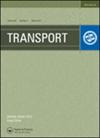基于时间交通状态模式的城市交通演化过程稳定性分析
IF 1.3
4区 工程技术
Q3 TRANSPORTATION SCIENCE & TECHNOLOGY
引用次数: 0
摘要
认识城市交通网络交通演化过程的稳定性一直是交通演化研究的重要内容。然而,关于交通状态模式与交通演化过程的识别和关联的研究却很少。通过对多维交通时间序列的聚类,我们试图将交通演化过程映射为连续tsp的大量转换。通过统计过渡的时间分布,定义稳定系数,定量分析交通演化过程。利用深圳市南山区路网30天多路段交通流率数据进行了实证研究。数值结果表明,交通演化过程在一天的不同时段呈现出明显的非线性变化,但从早到晚呈现出规律的循环特征。此外,考虑到工作日和周末不同的出行目的和交通特征,提取更多的交通动态,有助于理解交通演化过程的复杂行为。本文章由计算机程序翻译,如有差异,请以英文原文为准。
STABILITY ANALYSIS FOR URBAN TRAFFIC EVOLUTION PROCESS USING TEMPORAL TRAFFIC STATE PATTERNS
Recognizing the stability of the traffic evolution process of urban traffic networks has been an important consideration in traffic evolution research. However, little work has been conducted on identifying and associating temporal Traffic State Pattern (TSP) with the traffic evolution process. By clustering multi-dimensional traffic time series, we attempted to map the traffic evolution process into massive transitions of consecutive TSPs. Through the statistics of the time distribution of the transitions, we then defined the stability coefficient to conduct a quantitative analysis of the traffic evolution process. An empirical study using 30 days of traffic flow rate data of multiple road sections from the network of Nanshan District (Shenzhen, China) was carried out. Numerical results indicated that the traffic evolution process experienced obvious nonlinear changes at different periods of the day, but presented a regular cycle characteristic from morning till night. Further, with consideration of different travel purposes and traffic features on weekday and weekend, more traffic dynamics was extracted, which would be conducive to understand the complex behaviour of traffic evolution process.
求助全文
通过发布文献求助,成功后即可免费获取论文全文。
去求助
来源期刊

Transport
Engineering-Mechanical Engineering
CiteScore
3.40
自引率
5.90%
发文量
19
审稿时长
4 months
期刊介绍:
At present, transport is one of the key branches playing a crucial role in the development of economy. Reliable and properly organized transport services are required for a professional performance of industry, construction and agriculture. The public mood and efficiency of work also largely depend on the valuable functions of a carefully chosen transport system. A steady increase in transportation is accompanied by growing demands for a higher quality of transport services and optimum efficiency of transport performance. Currently, joint efforts taken by the transport experts and governing institutions of the country are required to develop and enhance the performance of the national transport system conducting theoretical and empirical research.
TRANSPORT is an international peer-reviewed journal covering main aspects of transport and providing a source of information for the engineer and the applied scientist.
The journal TRANSPORT publishes articles in the fields of:
transport policy;
fundamentals of the transport system;
technology for carrying passengers and freight using road, railway, inland waterways, sea and air transport;
technology for multimodal transportation and logistics;
loading technology;
roads, railways;
airports, ports, transport terminals;
traffic safety and environment protection;
design, manufacture and exploitation of motor vehicles;
pipeline transport;
transport energetics;
fuels, lubricants and maintenance materials;
teamwork of customs and transport;
transport information technologies;
transport economics and management;
transport standards;
transport educology and history, etc.
 求助内容:
求助内容: 应助结果提醒方式:
应助结果提醒方式:


